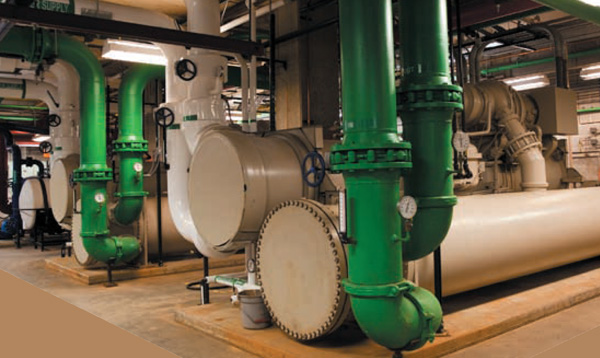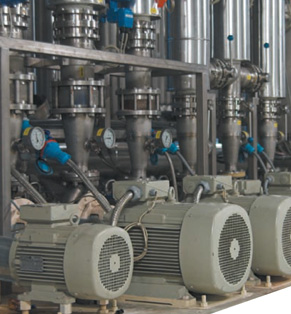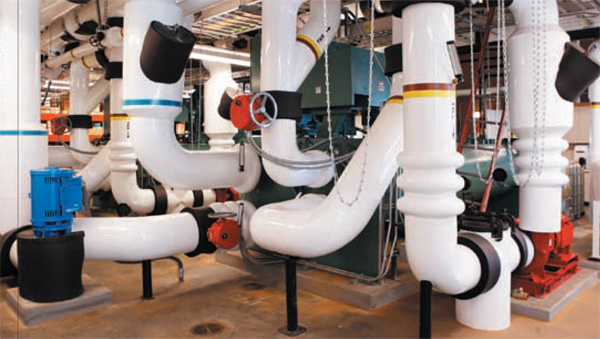Industry players explain how pumps can play a vital role in achieving performance and reliability of HVACR systems
The pumps industry is perceived to be slow-moving in terms of technology and innovation. Consequently, many facilities managers disregard pumps when looking for opportunities to improve performance and reliability of HVACR systems. Here, industry players explain how pumps can play a vital role in achieving this. Jerome Sanchez brings the report.

Pumps have long been serving as workhorses for the HVACR industry. Over the years, HVACR systems have changed owing to the strong presence of key drivers for innovation, including code compliance, environmental concerns, cost issues and development in technology and equipment. In many cases, believe industry players, tried-and-true solutions are falling by the wayside, replaced by innovative approaches to old problems.
Though the common perception in the industry is that pumps have not undergone such drastic changes compared to almost every other component in an HVACR system, pump manufacturers are said to have made significant improvements in impeller designs, construction materials, bearing and seal designs and couplings. Though some modifications have been introduced to pumps, many industry players still feel that these improvements are more “evolutionary” than “revolutionary”.
James Piper, PE, Ph D, a national consultant for Facilities Management, in his article “Pumps: The Heart of HVAC” that appeared in www.facilitiesnet.com, says that the perception about the changes in pumps, or the lack thereof, causes many managers to overlook the pump as an opportunity to improve the performance and reliability of HVACR systems. He adds that building designers replicate designs used in the past in new building designs and renovation plans, and system operating practices simply follow tried-and-tested methods. “When pumps fail, technicians replace them with new ones with the same characteristics,” says Piper.
Fortunately, the situation is changing today. As many advancements that have touched other areas of building HVACR operations are already being applied to pumps and their operation, engineering and maintenance managers are now reportedly able to achieve levels of operating efficiency that would not have been possible years ago. “While improved operating efficiency is a primary benefit of today’s pump installations, it is not the only one,” Piper explains. “System performance has improved, reliability has increased, and maintenance requirements have been reduced.”
The pump industry in the Middle East
 The pumps segment for the HVACR industry is pegged by industry players to be worth approximately USD 100 million. Raj Rishi Chauhan, Assistant Manager, Pumps Division, Faisal Jassim, provides an estimated breakdown of the size of the pumps sector: “The size of the market related to pumps in Saudi Arabia, UAE, Qatar and Oman is probably around USD 75 million. The construction industry size in the region is roughly USD 1 trillion. Out of this, Saudi Arabia holds 51%, UAE has 25%, Qatar has 13% and others with 11%.”
The pumps segment for the HVACR industry is pegged by industry players to be worth approximately USD 100 million. Raj Rishi Chauhan, Assistant Manager, Pumps Division, Faisal Jassim, provides an estimated breakdown of the size of the pumps sector: “The size of the market related to pumps in Saudi Arabia, UAE, Qatar and Oman is probably around USD 75 million. The construction industry size in the region is roughly USD 1 trillion. Out of this, Saudi Arabia holds 51%, UAE has 25%, Qatar has 13% and others with 11%.”
Sarfraz Dairkee, General Manager, M A H Y Khoory & Co does not provide an estimate of the market size of the pumps sector, but observes that the pumps market is linked to construction activities in the region. “The basic pump sets would roughly constitute about one per cent to 1.5%, and the entire pumping system, including the pipes, the fittings and controls, would be around two per cent to four per cent of the total construction costs,” he says.
The presence of construction activities is widely regarded by industry players to be one of the foremost drivers for growth of the pumps sector. Amidst the economic downturn of recent years, some countries, particularly in the GCC, have managed to take a defiant stance against the crisis. Saudi Arabia and Qatar are two countries in the region that still enjoy huge government spending on infrastructure and housing despite the economic crisis. Owing to the continuous growth in construction activities, industry players see a big potential for business in Saudi Arabia and Qatar.
Nadir Ilmas, Division Manager, ITT Pumps, Faisal Jassim, expresses this optimism, as the countries account for approximately 50% of the total construction activities in the region. “The construction market size is approximately USD 550 billion in Saudi Arabia and around USD 130 billion in Qatar,” Ilmas reveals.
Commenting on the promise Oman holds in the construction sector, and consequently for the HVACR industries, he says: “We also see Oman as an emerging market with a potential of over USD 4 billion. Oman, in the last few years, has seen major growth with new state-of-the-art airports lined up in Muscat, Salalah and Sohar.” He adds that tourism is also currently booming in Oman, that has resulted in the construction of at least 22 to 25 hotels in regions like Qasab, Muscat and Salalah. “There is also a new seaport under construction in Duqm. Obviously, a new port would need infrastructural development, including hotels, housing projects, and so on,” he adds.
Dairkee provides a more general view of the potential of the pumps market in the region in the light of strong construction activities in Saudi Arabia, Qatar and Oman. “Pumps for air conditioning are generally specified for multi-story buildings and dense development,” he says. Since dwellings, villas and smaller buildings still continue to rely on window and split air conditioners, in his opinion, the potential of the pumps market in these three countries will still depend on the development plan and the allocation of funds.
After the downturn
The global financial downturn is likely to put pressure on the investment, as well as on the operating costs. Dairkee thinks that this pressure will result in a call for better utilisation of resources with improvement in the efficiency and effectiveness of resources, in general, and energy and water, in particular. “Efficiency, therefore, is likely to affect profitability in more significant ways as compared to the past,” he explains, and adds that this stronger impact on profitability should open up requirements for energy audits and retrofitting of the systems to minimise on the cost. “Considering the increasing awareness and appreciation of environmental footprint, the sector providing effective turnkey services is likely to grow,” is his contention.
Ilmas and Chauhan are in the opinion that the global economy continues to benefit from an increasing globalisation and trade in a harmonious international environment, which they say, allows for a growth rate of over four per cent. Commenting on the situation during the downturn years, Ilmas and Chauhan explain that the recession of 2010 through 2012 was caused by oil shocks and a lack of trust that undermined international cooperation and trade integration.
For the present, however, adopting a more positive tone, the gentlemen from Faisal Jassim point out that the recovery has been steady and that an estimated 5,045 building construction projects are in progress. “The pumps and the HVACR market were affected by the downturn, but they are also recovering. We have increased our efforts throughout the GCC region and we were able to maintain our growth story,” say Ilmas and Chauhan.

The present-day pumps
With a heightened focus on cost and energy efficiency and sustainability of components of the HVACR systems, industry players predict that more funds will be pumped into research and development of new pumps to make them more efficient and more installation friendly. Ilmas and Chauhan cite the new Bell & Gossett VSX as an example of a technology that is headed that way. “Bell & Gossett VSX design is a major invention in this direction,” they say. “It is a brand new pump developed by Xylem, and can offer much better efficiency, much smaller footprint and price comparability and competitiveness.” They point out that a lot of control technology is coming in, like pump inbuilt variable frequency drives (VFD) and intelligent controls. Dairkee, too, notes that the current trend in pumps is moving towards automation for monitoring and for the building automation and management systems (BAMS).
Piper, in his article, speaks about intelligent pump controls systems. He says that VFDs are able to greatly improve the energy efficiency and control effectiveness of pumping systems, but intelligent pump controllers can offer more than that and can better adjust to system load changes, better control pump operations, provide control over a wider range of load conditions and produce smoother pumps startups. “Intelligent controllers also use VFDs to regulate pump speed, but they do so, not as a standalone device but as another element in the overall building automation system,” he elaborates, and adds that, by connecting the pump and its controller to a digital field bus, data from the pump and its sensors can integrate into the system. A program, then, monitors the operating conditions and identifies cases that are outside normal operations and those that could damage the pump.
Piper highlights that intelligent controllers can detect abnormalities like cavitation, sticking control valves and system leaks when programmed to do so. In his opinion, “Technicians can use the system to identify recurring or intermittent problems that, otherwise, might go undetected.”
Ilmas and Chauhan list other key improvements:
Market reception of technology and innovation
The common perception among industry players used to be that the market in the region is governed by price and not by quality, reliability and sustainability. Ilmas and Chauhan observe that the market in the region is now becoming conscious about quality, reliability and sustainability. They once again cite the example of the success story of Xylem pumps in the region. “Obviously, the customers today are looking for the best products with the most competitive price,” they say. “This is the way we have been pricing our product in the region. This is why Xylem products are being sold all across the region compared to other products.”
In Dairkee’s opinion, the market in the region is brand conscious and that it believes that reliability is linked to the brand rather than to better engineered solutions. “The appreciation of integrated design and of the fact that each application is unique is gradually sinking in, but at a very slow pace,” he says.
Add Ilmas and Chauhan: “We are seeing more and more trends towards more efficient pumps and motors. The region is slowly adapting to IE-3 design of motors, which are even more efficient than the earlier high-efficiency designs. The introduction of investment casting technology has made the pumps much more compact than before. The pumps are much lighter in weight and environmentally friendly in comparison to older, heavier designs.”
Dairkee highlights the fact that, at present, there is a move from the governments and municipalities in the region for the implementation of sustainable practices. However, he adds that in order for the initiatives to gain significant benefits, sustainability has to be adapted and closely integrated into the local environment.
Key challenges and maintenance
When asked about the key challenges their companies are facing in the region, Ilmas and Chauhan are unanimous in their opinion that over-sizing still remains an area of concern, as consultants put greater safety margin while selecting pumps. “We see a lot of pumps running at 50% to 60% of the rated RPM, whereby they work on lower part-load efficiency,” they say. “As you know, the efficiency of a pump drops substantially if you work on part-load.”
Dairkee seconds this observation. He points out that the main challenges in the region are with system optimisation and appreciation of the life cycle performance evaluation. “Energy efficiency is yet to be measured and, therefore, to be managed,” he says. “In fact, it is often the case of obese designs that cause system failures and draw the attention to the pumping system deficiency.”
Industry players are unanimous in their opinion that no matter how advanced the control system of one’s pumping system is, pumps will operate effectively and efficiently only if managers schedule its maintenance properly. Piper says that, unfortunately, facilities managers ignore maintenance until something goes wrong. The spokespersons from Faisal Jassim make the same observation. “As far as maintenance is concerned, we do not see a real service trend in the region. Most of the pumps run endlessly unless they breakdown,” they say, and explain that contractors normally finish the contract at the end of the defect liability period. Once this period is over, they point out, the building is taken over by a maintenance contractor who hardly maintains the pump.
More often, costs from pump repairs and disruption to building operations due to pump system failures exceed the cost of ongoing maintenance by a factor of 10 or more, Piper says. He adds that maintenance activities and the frequency with which they must be performed should vary with the capacity of the pump and the nature of the load it is serving. By checking the pump regularly, maintenance technicians will be able to identify pump problems early, thereby reducing repair costs and disruptions in operations, he suggests. In addition, he believes that maintenance personnel should follow the manufacturer’s recommended schedule of maintenance activities.
A few of the key maintenance issues cited by industry players are:
Dairkee sums up the issue on key challenges and maintenance, saying, “Pumps are simple and robust machines, and with better understanding of the variances, the system dynamics and integrated approach, much higher reliability and system efficiencies are achievable.”
Conclusion
For a pump installation to be successful, facilities managers need to change their ways of thinking about pumps. Managers need to keep themselves in tune with new technologies and innovations and seriously consider maintaining a regular schedule of preventive maintenance procedures. As Piper points out, if the managers stick with the old design and operating practices, the system will not be able to operate as efficiently and as reliably as it could. On the other hand, if they wait to adopt new technologies that are available, they will miss opportunities to ensure smooth building operation and enhanced energy efficiency.
Copyright © 2006-2025 - CPI Industry. All rights reserved.